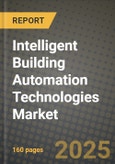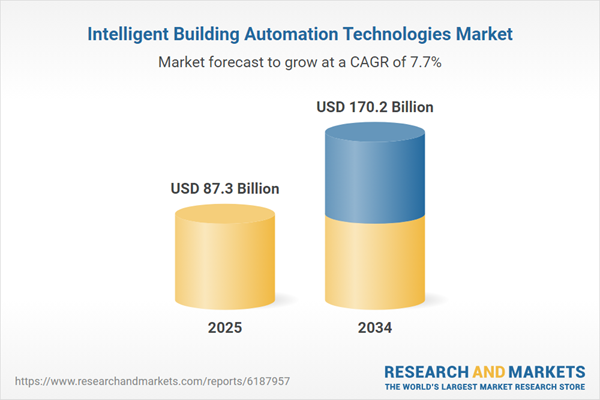The Intelligent Building Automation Technologies Market is revolutionizing how residential, commercial, and industrial spaces operate, with systems that autonomously monitor, control, and optimize building functions such as HVAC, lighting, security, and energy management. These technologies use real-time data from interconnected sensors, actuators, and software platforms to increase efficiency, reduce energy consumption, and improve occupant comfort. The market has seen a surge in adoption due to the growing emphasis on sustainability, smart cities, and cost-effective building operations. Facility managers and real estate developers are integrating intelligent automation not just for operational savings but also to meet green building standards and ESG compliance. With increased interest in IoT and AI, intelligent building systems are becoming more predictive and responsive, capable of adjusting to occupant behavior, climate conditions, and energy pricing. As governments push for decarbonization and building retrofitting, intelligent automation is no longer a luxury - it’s becoming a regulatory and economic necessity for future-proof infrastructure.
The Intelligent Building Automation Technologies Market advanced significantly as new policies and market pressures emphasized energy efficiency, occupant wellness, and building resiliency. European Union directives and U.S. green building incentives triggered widespread adoption of smart HVAC and lighting control systems in both new constructions and retrofits. AI-powered platforms were introduced to monitor air quality and occupancy in real time, with schools, hospitals, and office buildings being early adopters. Edge computing enabled faster decision-making in automation, reducing reliance on cloud latency and enhancing system responsiveness. Major players such as Honeywell, Siemens, and Schneider Electric unveiled new intelligent solutions that could integrate with legacy systems, allowing for smoother transitions in older buildings. Meanwhile, start-ups focused on modular and wireless sensor networks that reduced installation complexity. In addition to energy optimization, 2024 saw a focus on occupant-centric automation, with personalized climate and lighting control features based on individual preferences and usage patterns. The convergence of AI, 5G, and digital twin technologies also enabled comprehensive building analytics and remote troubleshooting capabilities, reshaping how building performance is managed and visualized in real time.
The Intelligent Building Automation Technologies Market is expected to accelerate with the integration of autonomous systems, sustainability mandates, and adaptive learning algorithms. Buildings will transition from reactive automation to proactive and even self-healing environments, capable of diagnosing faults, predicting maintenance needs, and auto-adjusting to changing external conditions. Governments are anticipated to introduce stricter building performance benchmarks and carbon neutrality targets, incentivizing deeper investments in intelligent retrofitting. AI-driven demand response systems will help buildings interact with smart grids, optimizing energy use based on peak pricing and availability. The integration of renewable energy sources, such as solar and wind, will be more tightly coupled with building automation for load balancing and storage management. Mixed-use developments and co-living spaces will see higher implementation of occupant behavior-based controls, driven by user-centric design philosophies. Furthermore, cross-domain interoperability standards are likely to emerge, enabling intelligent building systems to seamlessly integrate with city-wide digital infrastructure as part of broader smart city ecosystems. As the line between digital and physical environments continues to blur, intelligent building automation technologies will redefine how structures operate, consume resources, and respond to human presence.
Key Insights: Intelligent Building Automation Technologies Market
- The analyst highlights the integration of digital twin technology in building automation, allowing for real-time simulation and optimization of energy use, equipment lifespan, and occupant comfort across large-scale facilities and campuses.
- According to the analyst, adaptive lighting systems that adjust based on occupancy, daylight levels, and user preferences are becoming standard, improving energy efficiency and enhancing the wellness of building occupants.
- The analyst identifies the trend of personalized climate control, where AI algorithms learn individual occupant behavior to create customized thermal environments, increasing satisfaction and reducing unnecessary energy consumption.
- Integration of voice and gesture-based interfaces, as noted by the analyst, is transforming user interactions with building systems, especially in commercial offices and hospitality sectors where touchless control is now preferred.
- The analyst observes growing demand for cybersecurity in building automation systems as buildings become more connected, prompting manufacturers to embed threat detection and secure communication protocols into their automation platforms.
- The analyst notes the global emphasis on energy efficiency and carbon footprint reduction as a leading driver, pushing building owners to adopt automation systems that ensure compliance with environmental standards and cut operational costs.
- According to the analyst, the rise of smart cities and connected infrastructure projects is fostering investments in intelligent building automation to support seamless integration with municipal and regional digital ecosystems.
- The analyst emphasizes that occupant wellness and safety concerns - especially post-pandemic - are driving demand for air quality monitoring, contactless access, and automated sanitation systems within intelligent building frameworks.
- As noted by the analyst, the proliferation of affordable IoT sensors and wireless connectivity options is making intelligent automation financially viable even for mid-sized and older building stock through retrofitting solutions.
- The analyst points out that the lack of standardization in communication protocols and device compatibility continues to hinder seamless integration across automation systems from different vendors in complex building environments.
- According to the analyst, high upfront investment costs and long ROI timelines remain barriers, particularly for small property owners or developers in emerging markets who face tight capital expenditure constraints.
Intelligent Building Automation Technologies Market Segmentation
By Type
- Hardware
- Software
- Service
By Communication Technology
- Wired Technology
- Wireless Technology
By Application
- Residential
- Commercial
- Industrial
Key Companies Analysed
- Asea Brown Boveri Ltd.
- Azbil Corporation
- Eaton Corporation plc
- General Electric Company
- Ingersoll Rand Inc.
- Siemens Building Technologies Inc.
- Schneider Electric SE
- Honeywell International Inc.
- Hubbell Incorporated
- Rockwell Automation Inc.
- United Technologies Corporation
- Samsung Electronics Co. Ltd.
- Delta Controls Inc.
- Panasonic Corporation
- Robert Bosch GmbH
- Cisco Systems Inc.
- Trane Technologies plc
- Lutron Electronics Co. Inc.
- Johnson Controls International plc
- Beijer Electronics AB
- Emerson Electric Co.
- Mitsubishi Electric Corporation
- Hitachi Ltd.
- Huawei Technologies Co. Ltd.
- Creston Electronics LLC
- Legrand SA
- Bajaj Electricals Limited
- Building LogiX Inc.
- Distech Controls Inc.
- Dialight plc
Intelligent Building Automation Technologies Market Analytics
The report employs rigorous tools, including Porter’s Five Forces, value chain mapping, and scenario-based modeling, to assess supply-demand dynamics. Cross-sector influences from parent, derived, and substitute markets are evaluated to identify risks and opportunities. Trade and pricing analytics provide an up-to-date view of international flows, including leading exporters, importers, and regional price trends.Macroeconomic indicators, policy frameworks such as carbon pricing and energy security strategies, and evolving consumer behavior are considered in forecasting scenarios. Recent deal flows, partnerships, and technology innovations are incorporated to assess their impact on future market performance.
Intelligent Building Automation Technologies Market Competitive Intelligence
The competitive landscape is mapped through proprietary frameworks, profiling leading companies with details on business models, product portfolios, financial performance, and strategic initiatives. Key developments such as mergers & acquisitions, technology collaborations, investment inflows, and regional expansions are analyzed for their competitive impact. The report also identifies emerging players and innovative startups contributing to market disruption.Regional insights highlight the most promising investment destinations, regulatory landscapes, and evolving partnerships across energy and industrial corridors.
Countries Covered
- North America - Intelligent Building Automation Technologies market data and outlook to 2034
- United States
- Canada
- Mexico
- Europe - Intelligent Building Automation Technologies market data and outlook to 2034
- Germany
- United Kingdom
- France
- Italy
- Spain
- BeNeLux
- Russia
- Sweden
- Asia-Pacific - Intelligent Building Automation Technologies market data and outlook to 2034
- China
- Japan
- India
- South Korea
- Australia
- Indonesia
- Malaysia
- Vietnam
- Middle East and Africa - Intelligent Building Automation Technologies market data and outlook to 2034
- Saudi Arabia
- South Africa
- Iran
- UAE
- Egypt
- South and Central America - Intelligent Building Automation Technologies market data and outlook to 2034
- Brazil
- Argentina
- Chile
- Peru
Research Methodology
This study combines primary inputs from industry experts across the Intelligent Building Automation Technologies value chain with secondary data from associations, government publications, trade databases, and company disclosures. Proprietary modeling techniques, including data triangulation, statistical correlation, and scenario planning, are applied to deliver reliable market sizing and forecasting.Key Questions Addressed
- What is the current and forecast market size of the Intelligent Building Automation Technologies industry at global, regional, and country levels?
- Which types, applications, and technologies present the highest growth potential?
- How are supply chains adapting to geopolitical and economic shocks?
- What role do policy frameworks, trade flows, and sustainability targets play in shaping demand?
- Who are the leading players, and how are their strategies evolving in the face of global uncertainty?
- Which regional “hotspots” and customer segments will outpace the market, and what go-to-market and partnership models best support entry and expansion?
- Where are the most investable opportunities - across technology roadmaps, sustainability-linked innovation, and M&A - and what is the best segment to invest over the next 3-5 years?
Your Key Takeaways from the Intelligent Building Automation Technologies Market Report
- Global Intelligent Building Automation Technologies market size and growth projections (CAGR), 2024-2034
- Impact of Russia-Ukraine, Israel-Palestine, and Hamas conflicts on Intelligent Building Automation Technologies trade, costs, and supply chains
- Intelligent Building Automation Technologies market size, share, and outlook across 5 regions and 27 countries, 2023-2034
- Intelligent Building Automation Technologies market size, CAGR, and market share of key products, applications, and end-user verticals, 2023-2034
- Short- and long-term Intelligent Building Automation Technologies market trends, drivers, restraints, and opportunities
- Porter’s Five Forces analysis, technological developments, and Intelligent Building Automation Technologies supply chain analysis
- Intelligent Building Automation Technologies trade analysis, Intelligent Building Automation Technologies market price analysis, and Intelligent Building Automation Technologies supply/demand dynamics
- Profiles of 5 leading companies - overview, key strategies, financials, and products
- Latest Intelligent Building Automation Technologies market news and developments
Additional Support
With the purchase of this report, you will receive:- An updated PDF report and an MS Excel data workbook containing all market tables and figures for easy analysis.
- 7-day post-sale analyst support for clarifications and in-scope supplementary data, ensuring the deliverable aligns precisely with your requirements.
- Complimentary report update to incorporate the latest available data and the impact of recent market developments.
This product will be delivered within 1-3 business days.
Table of Contents
Companies Mentioned
- Asea Brown Boveri Ltd.
- Azbil Corporation
- Eaton Corporation PLC
- General Electric Company
- Ingersoll Rand Inc.
- Siemens Building Technologies Inc.
- Schneider Electric SE
- Honeywell International Inc.
- Hubbell Incorporated
- Rockwell Automation Inc.
- United Technologies Corporation
- Samsung Electronics Co. Ltd.
- Delta Controls Inc.
- Panasonic Corporation
- Robert Bosch GmbH
- Cisco Systems Inc.
- Trane Technologies PLC
- Lutron Electronics Co. Inc.
- Johnson Controls International PLC
- Beijer Electronics AB
- Emerson Electric Co.
- Mitsubishi Electric Corporation
- Hitachi Ltd.
- Huawei Technologies Co. Ltd.
- Creston Electronics LLC
- Legrand SA
- Bajaj Electricals Limited
- Building LogiX Inc.
- Distech Controls Inc.
- Dialight PLC
Table Information
| Report Attribute | Details |
|---|---|
| No. of Pages | 160 |
| Published | October 2025 |
| Forecast Period | 2025 - 2034 |
| Estimated Market Value ( USD | $ 87.3 Billion |
| Forecasted Market Value ( USD | $ 170.2 Billion |
| Compound Annual Growth Rate | 7.7% |
| Regions Covered | Global |
| No. of Companies Mentioned | 30 |









